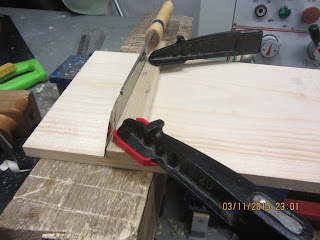I had hoped for a paint finish, but since it will probably be given away for someone as a Christmas present, I chose to stick to what she wanted.
But there were no restrictions to the treasure chest with curved lid that I made some time ago. That thing has just been sitting idle under a table to be out of the way.
I asked Asger if he would like to paint it, and he was really exited about it. I decided to give up most of the control and told him that he could choose the colour.
We looked at the paint shelf, and I tried my best to advocate for a green, blue or red coat of paint. But Asger was not convinced that it was the right path. Finally he made up his mind and settled for Massey Ferguson light grey, a classic tractor colour.
He rolled on a coat of paint that quickly got absorbed by the wood. So we agreed that was a primer, the next day he rolled on another coat, and that helped a lot.
Finally I added the last layer using a brush instead of the roller, because our cheap roller more or less dissolved in the oil based paint.
I had made some hardware on the ship while I made the chest itself. An escutcheon and parts for some lifts.
The lift handles themselves are old handles from some metal pails that comes with various chemicals and soap.
Since I made a treasure chest, I opted for some fantasy inspired hardware. something that could spark an interest in a child. So I made a dragon/vampire bat as a theme.
It turned out better than I had hoped for. But I think they would have stood out more if the chest had been in a different colour.
The finished treasure chest.
Asger sanding
Asger painting
Painting
Dragon escutcheon
Dragon lift












